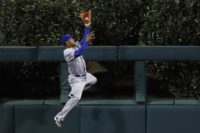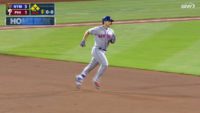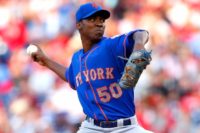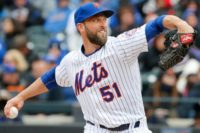Terry Collins

All you need to know about tonight’s game is the Mets scored a franchise record 12 runs in the third inning. Here’s how it happened:
A 12-run inning? That’s the highest-scoring frame in @Mets history. https://t.co/mLUBSOeNVe pic.twitter.com/4eUVXnWN2U
— MLB Stats (@MLBStats) April 30, 2016
Watch @ynscspds cap off our 12-run inning with a grand slam! #Metshttps://t.co/0Z4NwYW4Gb
— New York Mets (@Mets) April 30, 2016
As Ron Darling would later say, “You got the feeling that the inning might not ever end.” This inning was a far cry from the 2015 Mets June/July offense. The Mets sent 15 batters to the plate. The only Mets batter that didn’t reach base or score at least once was pitcher Steven Matz. With his grand slam and six RBI, Yoenis Cespedes broke Butch Huskey‘s team record of five RBI in one inning. Who knew?
The inning was so impressive Jake Peavy‘s ERA went from 6.86 to 8.61. The Mets scored half their runs off Peavy and the other half off of sacrificial lamb Mike Broadway. His ERA went from 3.86 to 11.81.
Matz lasted six innings allowing seven hits, zero earned, three walks, and four strikeouts. It wasn’t a dominating performance. He only had one 1-2-3 inning. With that said, he more than got the job done. The only run scored by the Giants was a leadoff homerun on the seventh inning by Angel Pagan off of Jerry Blevins. It was a good decision by Terry Collins to give Blevins a full inning of work in a blowout. Blevins has been the least used member of the bullpen.
As if they were irritated by Pagan’s homer, the Mets rallied again in the seventh to score a run. The 13th run of the game was scored on a Juan Lagares RBI single. Logan Verrett pitched a scoreless eighth, and Antonio Bastardo pitched a scoreless ninth to close out the 13-1 victory. I’m assuming Verrett, the long man in the pen, didn’t pitch two innings because Terry Collins’ Magic 8 Ball told him to do it.
This was the Mets first game this season against a National League team that was expected to be a contender for not only the postseason, but also the World Series.
Game Notes: Kevin Plawecki threw out Brandon Belt in the second. He’s now 5-9 in throwing out would be basestealers. Since taking over for the injured Travis d’Arnaud, he’s gone 2-13. David Wright, who for some reason wasn’t pulled, continued his throwing issues with a throwing error in the eighth. Eric Campbell entered the game to play LF in the eighth. Michael Fulmer made his debut for the Tigers against the Twins. He went five innings allowing two earned, one walk, and four strikeouts.
Around this time last year, David Wright was on the DL with a quad injury. He would soon find out that he was suffering from spinal stenosis, a condition which would forever impact his career. It would forever change not just his ability to play in games, but also how he prepares for games.
We’ve seen back issues cause players like Don Mattingly and Lenny Dykstra to retire early in their 30’s. However, as Danny Knobler reports for ESPN.com, Wright is not at that point no matter how frustrating, grueling, and tiresome his pregame routine can be:
“Every day it sucks,” Wright said late Tuesday night. “Every day it sucks getting ready for the game. But I enjoy playing the game. So it’s worth it. You know, it’s no fun doing the preparation for the preparation, but I want to play and give myself the best chance to be healthy, you’ve got to do what you’ve got to do.”
Wright’s “preparation for his preparation” begins five hours before first pitch. Wright needs at least two hours ready just to prepare himself to take batting practice. Everyone one sees what Wright goes through on a daily basis. As his manager, Terry Collins, said, “I know David. He’s fighting it really, really hard.”
Wright is working hard, and he knows he’s doing what’s necessary for him to get out on the field. As he said, “I’m satisfied I’ve put in the work to be able to play,” but “[y]ou’re never satisfied with where you are as a player.”
As a player, Wright is hitting .238/.342/.444 with seven doubles, two homeruns, four RBI, and two stolen bases. Last night, he had the game winning hit against the Reds. Moments like last night is no surprise to Collins, who said, “Great players do unbelievable things when you need them to.”
With that said, both Collins and Wright both acknowledge Wright won’t be available to do it every time he’s needed. As Collins said, “He has to come to me everyday and tell me how he feels.” Wright does as he’s acknowledged his limitations saying, “I know what’s best for me and the team is that I get those occasional days off.” As Wright said to Collins, “I’ve got to make sure I don’t overdo this.”
So far this year, there are no signs that Wright is overdoing anything. He’s taking days off, and he’s doing what is necessary to prepare for each game. It’s part of Wright’s new reality, but as he said, “you’ve got to do what you got to do.”
Editor’s Note: this article first appeared on metsmerizedonline.com.
Earlier today, I published a proposal to change the way the fans vote for the All Star Game. To show how this may work, here is my best guess on how the fans may vote based upon if fans were voting today:
AMERICAN LEAGUE
AL East
Baltimore Orioles – Manny Machado 3B
Boston Red Sox – David Ortiz DH
Toronto Blue Jays – Josh Donaldson 3B
Tampa Bay Rays – Kevin Kiermaier CF
New York Yankees – Dellin Betances RP
AL Central
Chicago White Sox – Chris Sale SP
Kansas City Royals – Alex Gordon LF
Cleveland Indians – Francisco Lindor SS
Detroit Tigers – J.D. Martinez RF
Minnesota Twins – Joe Mauer 1B
AL West
Oakland Athletics – Sonny Gray SP
Texas Rangers – Adrian Beltre 3B
Seattle Mariners – Felix Hernandez SP
Los Angels Angels of Anaheim – Mike Trout CF
Houston Astros – Jose Altuve 2B
Now, as the season progresses and players improve, we could see changes here and there like Miguel Cabrera in place of J.D. Martinez. Overall, this looks to be a fair projection. Of the 15 players selected, there were three starting pitchers, one reliever, no catchers, one first baseman, one second baseman, three third baseman, one shortstop, one left fielder, two centerfielders, one rightfielder, and a DH. With nineteen spots left, there is plenty of room left to assemble a complete All Star Game roster.
NATIONAL LEAGUE
NL East
Washington Nationals – Bryce Harper RF
New York Mets – Noah Syndergaard SP
Philadelphia Phillies – Vincent Velasquez SP
Miami Marlins – Giancarlo Stanton RF
Atlanta Braves – Freddie Freeman (?) 1B
NL Central
Chicago Cubs – Anthony Rizzo 1B
St. Louis Cardinals – Yadier Molina C
Pittsburgh Pirates – Starling Marte LF
Cincinnati Reds – Zack Cozart SS
Milwaukee Brewers – Ryan Braun LF
NL West
Los Angeles Dodgers – Clayton Kershaw SP
Arizona Diamondbacks – Paul Goldschmidt 1B
Colorado Rockies – Nolan Arenado 3B
San Francisco Giants – Buster Posey C
San Diego Padres – Melvin Upton, Jr. LF
In total, the National League would have three starters, no relievers, two catchers, three first basemen, no second basemen, one third baseman, one shortstop, three left fielders, no centerfielders, and two rightfielders. Again, there’s plenty of room to fill in the rest of the roster.
OVERALL
By no means should my choices here be interpreted as the final say or who I would vote for if these rules were adapted. It’s only a guess.
With that said, there are some young and exciting players here like Syndergaard and Lindor. There are bona five superstars like Harper and Trout (who also qualify as young and exciting). Also, there are players here like Freeman and Velasquez, who may not be chosen to an All Star Game, but nevertheless, they would be there because every team must be represented. Look, if you’re going to name someone to the All Star Game who wouldn’t be there but for one rule, you might as well let those fans pick the players.
At the end of the day, these are mostly deserving All Stars, and their inclusion would not hamper Ned Yost’s or Terry Collins’ ability to field a team. It’s time to let fans pick their own players.
Before the game, Matt Harvey declared he figured out his mechanical problems, and that he was back. He took no chances as the Mets ore the traditional road grays instead of the blue alternates he prefers. The Mets need him to be back because he has not resembled the Matt Harvey we’ve seen:
Harvey in his career:
Bases empty: .199/.247/.296
Men on: .252/.302/.365 https://t.co/SqB05IV6Hd— Michael Mayer (@mikemayer22) April 22, 2016
First inning, Harvey came out guns blazing. He got three quick outs, including one strikeout. After the first, it was a struggle. It could’ve been the same problems he’s had all year. It could’ve been the delay due to the need to change home plate umpires due to the home plate umpire getting injured on a foul tip. In any event, Harvey’s pitches were up. His velocity was generally down (about 1-2 MPH), and the Braves were making solid contact.
Fortunately, the Braves were only able to score runs in the second. The first was an RBI single by old friend Kelly Johnson. Another run would score off an RBI double by Mallex Smith. Harvey would be in trouble most of the night. He would’ve allowed more runs in the fifth but for Yoenis Cespedes’ arm:
N'uh uh says the ?? of @ynscspds. #Metshttps://t.co/iwIPlyq0QU
— New York Mets (@Mets) April 23, 2016
Keith Hernandez was right. He missed the cut-off man, but it was a near perfect throw that got the runner. It reminded me of Major League when Lou Brown essentially said to Willie Mays Hayes to never do it again.
Cespedes also left his impression at the plate with his seventh game with an extra-base hit. In the seventh, he hit an RBI double to score David Wright, who hit an opposite field one out double himself. Cespedes came up gingerly after sliding awkwardly into second. It should’ve been a standup double, but he didn’t break it out of the box presumably thinking it was a homerun. A noticeably uncomfortable Cespedes stayed in the game despite the a Mets having a 6-2 lead. He would eventually have to be pulled:
Juan Lagares had already taken the field for the bottom of the eighth before the rain delay started. Yoenis Cespedes was leaving game.
— Adam Rubin (@AdamRubinMedia) April 23, 2016
Curtis Granderson was responsible for the other five. In the second, Granderson hit his first grand slam as a Met. In his very next at bat, he hit a solo shot off of Braves’ starter Bud Norris. Granderson looks to be rounding into his 2015 form after a tough start.
Blame @cgrand3 for the ☔️. He's brought a lot of it tonight. #GrandSlam #SoloHR pic.twitter.com/NOhszhy788
— New York Mets (@Mets) April 23, 2016
The Mets’ bullpen would come through to get Harvey his first win of the year. Antonio Bastardo pitched 1.2 innings before needing to be pulled with runners on first and second. Jim Henderson only faced one batter – it was the seventh after all- and he allowed an RBI single to Adonis Garcia. Jerry Blevins came on and ended the rally by striking out A.J. Pierzynski. Blevins was the only one to get Pierzynski out all night.
After about an hour rain delay, Addison Reed came on to pitch the eighth. Originally, it was supposed to be Blevins, but the rain eliminate that option. Reed pitched a scoreless eighth despite a throwing error from Asdrubal Cabrera.
Jeurys Familia had a save opportunity in the ninth because God has a good sense of humor. With Cespedes out if the game, Terry Collins allowed Michael Conforto hit against Eric O’Flaherty. Conforto hit a soft liner to the shortstop, and Juan Lagares was doubled off of second for the inning ending double play. It didn’t matter. Familia pitch a scoreless ninth to preserve the 6-3 win.
In any event, Harvey struggled. He only pitched five innings allowing seven hits, two earned, one walk and five strikeouts. He fought through it. He still had work to do, but at least he has a win under his belt.
Game Notes: Freddie Freeman got his first hit in 20 at bats against Bastardo, who Collins was trying to pitch for two innings. While Harvey was struggling, Travis d’Arnaud tried talking to Harvey in the dugout. A visibly frustrated Harvey wanted none of it.
On another note, Ricky Bones was the pitching coach. Dan Warthen missed the game because he was attending his mother’s funeral. Our thoughts and prayers are with the Warthen family at this time.

The Mets roster is full of game changers. The pitching staff can change a game with their dominating stuff. Most of the lineup can change the game with the swing of the the bat. However, there’s only one gamechanging defensive player.
Lagares won the Gold Glove in 2014 despite playing in only 116 games. He was that good. His UZR was 18.5, and his DRS was 26. These are elite numbers. His numbers were better in 2013 when his UZR was 21.5, and his DRS was 26. Overall, he’s a deserving Gold Glover. Time and again, he can change a game by getting to a ball no one else could field. He’s a game changer in the field.
Except last year. Lagares’ offense and defense slipped noticeably. Yes, he had an elbow injury that was rumored to require Tommy John surgery. However, that would explain his offense and throwing more than his range. Last night, Lagares showed everyone that he’s back:
That right there is Lagares’ true value. He saved three runs there (even if it didn’t matter in terms of the game). While Terry Collins may look to platoon Lagares with Michael Conforto to get Lagares’ bat in the lineup against lefties. Collins is mistaken. The Mets don’t need Lagares’ bat. They need his glove. They need him out there late in the game to protect leads with his play in the field.
He will make a catch like he made last night again – only next time it’s going to change the outcome of a game.

Thank goodness for PIP (picture in picture) technology. Because of that, I was able to watch both the Mets-Phillies game and Game Three between the Rangers and Penguins. By the way, if not for my wife and the Declaration of Independence, I’d propose getting rid of Pennsylvania a together.
In any event, the Mets did all people who were both Mets and Rangers fans a huge favor tonight by blowing out the Phillies and giving Rangers fans something to cheer about.
While the Phillies have terrific young starting pitching, we were reminded of the perils of relying on young pitching. While Vincent Velasquez has pitched incredibly well this season (including a terrific game against the Mets), he struggled against the Mets. The Mets jumped on him right away when Michael Conforto hit a two run homer in the first. It was not a good start for Velasquez who only lasted 4.1 innings allowing five hits, five runs (two earned), no walks, and four strikeouts. With the Phillies bullpen, the game was over once Yoenis Cespedes did this:
Watch @ynscspds do bad things to this baseball >> https://t.co/9FZRBHOap4. 5-0 #Mets! ?https://t.co/9ONhf9egGN
— New York Mets (@Mets) April 20, 2016
This was more than enough for Logan Verrett, who once again had a terrific spot start. Verrett would go six innings allowing six hits, no runs, one walk, and four strikeouts. He seemingly had someone on every inning, but he navigated how way through all the trouble.
Overall, it was the type of night you expected from a World Series contender against a team that’s expected to contend for the first pick in the draft. The Mets offense went off hitting six homeruns. Aside from the aforementioned homeruns, the Mets got homeruns from Lucas Duda, Curtis Granderson, and two from Neil Walker. Walker gave one a ride in the ninth but fell just short of a three homerun game. All told, the Mets would score 11 runs.
Things went so well, there was even a Rafael Montero sighting. Keep in mind, that was only after Terry Collins pitched Jim Henderson of an inning to protect the then 9-0 lead. As always, the seventh inning belongs to Henderson.
Montero wasn’t good. He allowed two hits, one earned, one walk, and two strikeouts. It would’ve been much worse if not for a Gold Glove play by Juan Lagares, who came into the game after the blowout started, robbing Maikel Franco of a homerun:
Juan doing Juan things. #Juanderful @juanlagares2https://t.co/a7kqGxuajP
— New York Mets (@Mets) April 20, 2016
Naturally, Collins gave the ball to Hansel Robles in the ninth to preserve the 11-1 victory rather than letting the long man Montero, who will soon be sent back to Triple-A, finish the game.
Right now, the Mets are beginning to get in a rhythm and are beating up on bad teams. It’s what they did very successfully last year. It’s what they’ll need to do in order to return to the postseason.
Game Notes: The Mets are back over .500 at 7-6. Every Mets starter got a hit, including Verrett, who had his first career hit. Verrett has not allowed a run in 12 innings as a starter. Travis d’Arnaud returned to the lineup after getting hit on the elbow on Saturday. The referees are still calling the Rangers-Penguins one-sided even as Sidney Crosby asks for the Rangers to get a game misconduct for giving him a mean look. Rangers trail the Penguins 2-1 in the series.
* photo from the Mets Twitter account

Since David Wright has put on a uniform, he has been a great player. He has become the face of the franchise, if not all of baseball. We’ve seen him overcome all obstacles. He overcame the original inane Citi Field outfield configuration. He overcame a broken back. He’s overcome bad players and managers. Through all of it Wright has become a borderline Hall of Famer.
Wright has been facing his toughest test with his battle with spinal stenosis. So far, he’s handled that the same way he’s always faced adversity.
When Wright first came off the DL, he homered in his first at bat. He would hit .277/.381/.437 with four homers and 13 RBI in 30 games. He would then hit the first ever World Series homerun in Citi Field history:
Despite all of what Wright has overcome, and despite what he has done while playing with the spinal stenosis, he still has his doubters. After an admittedly rough Opening Day, writers like Buster Olney were beginning to write the postmortem for Wright’s career. Articles like these were as premature as they were wrong.
So far this year, Wright has reached base in each and every game he has played. He’s shown a good eye at the plate drawing a walk in all but two games. By the way, in the two games he didn’t draw a walk, he had multiple hit games. So far this year, he’s hitting .289/.426/.526. His career line is .298/.377/.493. Last night, we also got to see him hitting the ball to the opposite field with authority, which has always been a David Wright staple:
Everything was all Wright in Philadelphia last night. #DavidWright #Metshttps://t.co/irfWSwJMBv
— New York Mets (@Mets) April 19, 2016
As Terry Collins would tell you, he’s not in the least surprised. Furthermore, he believes that no one should be surprised at what David Wright is doing. As Collins said in the postgame press conference, “Star players should never surprise you with what they can do.”
Yes, David Wright is still a star, and no, no one should be surprised at what we’re seeing. Wright has been doing this his entire career, and he will continue to do so.
Editor’s Note: this article first ran on metsmerizedonline.com

With the Mets bullpen on fumes from a very short Steven Matz start and Logan Verrett making a spot start in place of an injured Jacob deGrom (our prayers are with him and his family), the Mets recalled Rafael Montero to add a fresh arm to the bullpen mix. The Mets needed an extra arm after the bullpen pitched 7.1 innings on Monday without any contributions from their long man. It was a waste of a move. At this point, it’s clear Montero is in Terry Collins’ doghouse, and Collins won’t use him until he’s burned out all of the other arms on the bullpen.
On Wednesday, Collins controversially pitched Jim Henderson despite him having problems locating his pitches and throwing more pitches he ever had in one game the previous night. Collins then proceeded to use Hansel Robles, who pitched 2.2 innings on Monday. Collins went to four relievers that day to preserve a 2-1 win.
On Friday, the Mets had a four run lead. Collins first turned to Antonio Bastardo to get out of a sixth inning jam. He then have way to Robles for 0.1 of an inning. At that point, the Mets had a four run lead in the eighth inning. Collins turned to Addison Reed to get the last six outs. Reed got five and allowed two runs in the process. Collins decided to let Jeurys Familia pitch for the fourth time in four games. Despite allowing a run, he recorded the save.
At no point in either of these games did Montero so much as warm up.
An argument can be made for not using Montero Wednesday because of how close the game was. The Mets were in the midst of a frustrating losing streak, and Collins wanted his best arms out there to get the win. With that said, there’s no reason why Montero didn’t pitch on Friday. After Bastardo got out of the jam, the Mets had a four run lead. That was the perfect spot for Montero.
Instead, Collins asked both Bastardo and Reed to pitch over an inning. He asked two middle relievers to pitch more than an inning rather than asking the long man in his bullpen to pitch more than an inning. Collins was ready, willing, and able to once again tire out his bullpen rather than putting Montero in a game to preserve a four run lead. At this point, it’s fair to say either Collins doesn’t trust Montero, has him in his doghouse, or both.
It’s strange to think it’s reached this point when Collins has tried to get the most out of Montero.
Last August when things were starting to take off for the Mets, Collins drove to Port St. Lucie to have a conversation with Montero in order to tell him the Mets still needed him. At that time, Montero was dealing with shoulder issues. The Mets insisted there was nothing wrong while Montero felt like it prevented him from pitching. Montero tried to make that comeback, but he would have a setback in a rehab start. His season was over.
In Spring Training, Collins again took time to deliver a special message for Montero. As Tim Rohan of the New York Times reported, Collins told Montero, “Get your act together. We haven’t forgotten about you. We still want you.” Collins gave him the start in the Mets first Spring Training game. Montero allowed the first five guys to reach base. In total, he allowed four runs, four hits, and two walks in one inning of work. Montero would not pitch in another game, and he would be in the first group of Spring Training cuts.
At this point, the Mets need Montero. He’s gotten his act together with some mechanical adjustments in Triple-A. However, it’s too little too late. Collins has either forgotten him or doesn’t want him anymore.

After Johan Santana threw 134 pitches on a surgery repaired shoulder to throw the first no-hitter in Mets history, Terry Collins was in tears. He seemed distraught. In the post-game press conference, Collins called Santana his “Hero,” and he was prescient in saying:
I’m very excited for him, but in five days, if his arm is bothering him, I’m not going to feel good.
As we know, even though Santana would make 10 more starts, his career effectively ended that night. He would need another shoulder surgery in the offseason. Between that surgery and other injuries, Santana has never pitched in another big league game.
When Collins was interviewed by Phil Taylor of Sports Illustrated three years later, Collins expressed his remorse. He would say, “It was without a doubt, the worst night I’ve ever spent in baseball.” Now, no one really knows what effect this game had on the need for Santana to have a second surgery. However, for his part, Collins thinks the no-hitter had a lot to do with it:
I was aware of what the wear and tear of that night could do to him, and basically, the worst-case scenario happened. To throw that amount of pitches with that much pressure and that much adrenaline going, it can beat you down. And it did.
If Collins truly believes that, it makes what he did with Jim Henderson all the more indefensible.
Henderson has come a long way to get here. He’s had two shoulder surgeries himself. He fought against all odds to make the Mets Opening Day roster. Not only did he make the roster, he quickly established himself as a very important part of the Mets bullpen.
So far this year, Henderson has pitched in five of the eight games the Mets have played. On Tuesday, he threw 34 pitches, which was the most he’s ever thrown in one game. Wednesday was a day game. The Mets added Rafael Montero to the roster so the Mets would have a full bullpen for the game. With the score tied 0-0 in the seventh inning, Collins put Henderson in the game.
Before Wednesday’s game, Henderson’s fastball averaged 95 MPH. On Wednesday, he was sitting around 89 MPH. He allowed a single and two hits before Collins pulled him from a game he shouldn’t have entered in the first place. Collins excuse?
TC: "Henderson said before the game that he felt great."
— Steve Gelbs (@SteveGelbs) April 13, 2016
It’s difficult to believe that Collins used this as a justification. He says he is troubled by Santana’s no-hitter, and he thinks it had a profound impact on effectively ending his career. Why would he willingly do the same thing again with another player? Why would he go to Henderson when there were other, fresher options? It doesn’t make sense.
It should be noted that Collins had a different tone in Wednesday’s press conference than Santana’s. Collins was fired up. There was no hint of him fearing for Henderson’s future.
Collins thought this was a must-win game, but it’s a stretch to believe he would sacrifice a player’s health for it. Collins said he was desperate, but there has to be a line. Collins might’ve wanted to respond to people questioning the Mets effort, but putting a player’s health and career in doubt, you prove nothing.
At the end of the day, Terry Collins has shown he has learned nothing. While we all understood him leaving Santana in, there was no excuse for pitching Henderson there. Collins could’ve ended someone’s career for what really was just another April game. Overall, Mike Vaccarro put it best when he chastised Collins:
Shame on Terry Collins. That wasn't just reckless game managing, but it put his pitcher's health in peril. #Mets
— Mike Vaccaro (@MikeVacc) April 13, 2016
Collins has had some nice moments as the manager of the Mets. Wednesday wasn’t one of them. Collins once called Santana’s no-hitter the worst night of his baseball life. Wednesday could’ve been the worst day of Henderson’s professional life, but Collins showed no remorse. Collins may be haunted by Santana’s no-hitter, but he has clearly showed he’s learned nothing from it.
Editor’s Note: this was first published on metsmerizedonline.com
